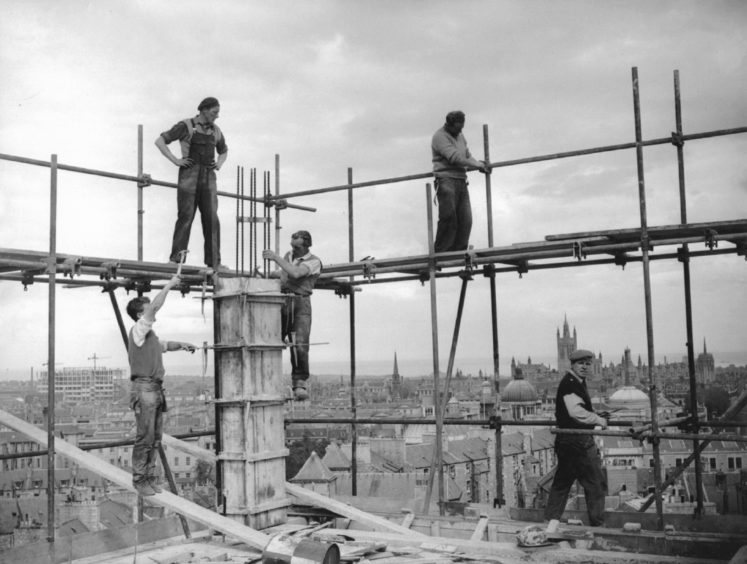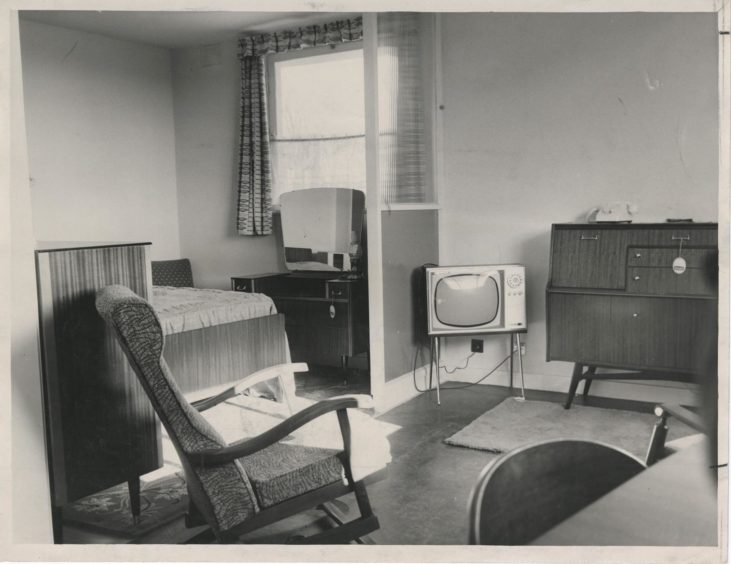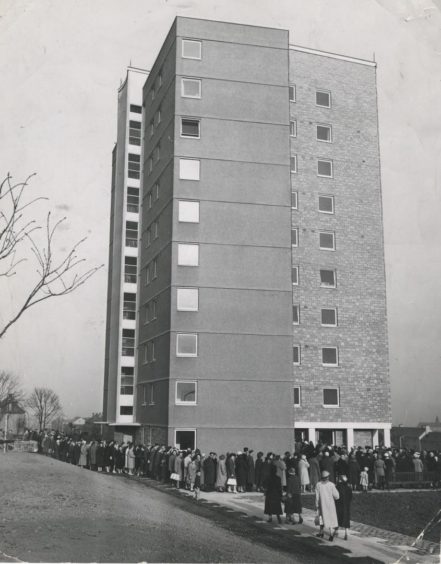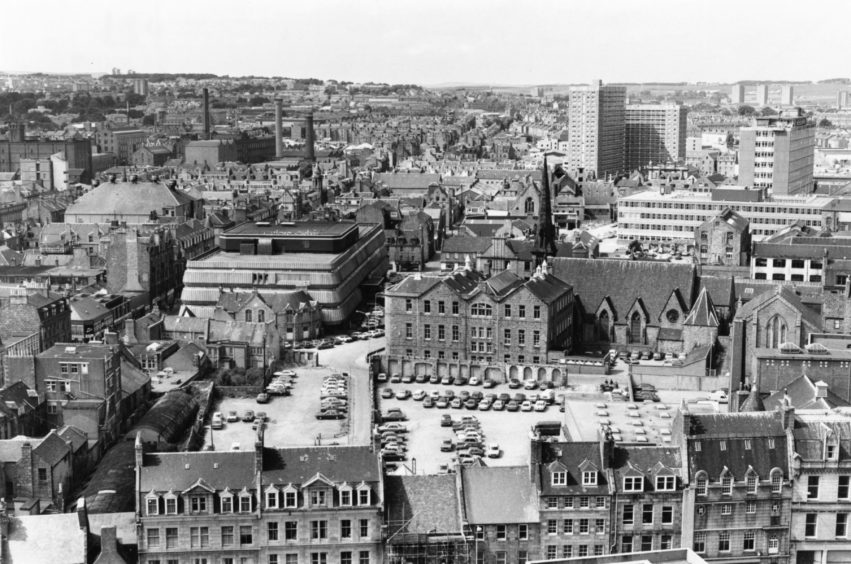They were the buildings which were supposed to help Aberdeen residents advance into a bright new future.
In 1950, when Baillie Frank McGee, the city’s housing convenor, announced he was determined to eradicate the “appalling slums” which still existed, he confirmed that he and his colleagues were not interested in short-term solutions.
Instead, he proclaimed: “We are not going to build tenements, but something we will be proud of and something which will hopefully win another Saltire Prize.”
It was the launch of a major new venture which, in 1952, led to the local authority approving the Granite City’s first ‘multi’ – a nine-storey block in Ashgrove Road which opened 60 years ago in March 1961 – and that was the template for the subsequent creation of many high-rise structures.
Eight of them – Gilcomstoun Land, Porthill Court, Seamount Court, Virginia Court, Marischal Court, Thistle Court, Hutcheon Court, and Greig Court – were built and also opened in the 1960s and, six decades later, these tower blocks were all given category A-listed status by Historic Environment Scotland in January this year.
It was a controversial decision which provoked strong criticism from members of the public and a rare sign of cross-party unity among the city’s political groups.
But what was life like for the people who lived and grew up in these places?
‘The early caretakers helped a lot’
Graham Sherriffs was among the residents whose initial positivity about the high rises was gradually replaced by a sinking feeling.
He said: “We loved living at Seamount Court [from 1979 to 1992] and our two children were brought up in what was a great community spirit and good mix of age groups.
“There was a real sense of pride from the residents with communal cleaning being done on a regular basis and both Seamount and Porthill had caretakers which helped a lot.
“The surrounding areas were also much better maintained, but sadly, by the time we moved across the road, an influx of undesirable tenants had started to move in.
“I believe that bad choices by the council allowed this to happen and, around the same time, the introduction of contract cleaners and dismissal of resident caretakers contributed to the falling standards.
“I don’t understand this listed buildings stuff, I don’t feel they are historic in any way, in fact this news could make repairs expensive for both the council and the owners.
“I now reside fairly nearby, and I love it, but it saddens me to see the level of neglect there has been in maintaining the skyscrapers. The Gallowgate area has become a forgotten zone [in the city] and I think it badly needs investment.”
Family pride was there at the outset
Ian Young and his wife, Marilyn, moved into Hutcheon Court in the mid-1970s and shared Graham’s opinion of the community spirit which existed at the outset.
He said: “We had moved up to the city from the central belt to study and didn’t have a lot of money at that stage, but we were thrilled when we ended up in the high rise.
“We kept in touch with the older members in the building and there was a really upbeat atmosphere. I’m not going to pretend it was like The Waltons – one or two of the lads liked a drink and you’d sometimes hear them singing at the top of their voices.
“But there was a feeling we were all in this together, so we often got our hands dirty to do some cleaning, and a few of the younger folk bought the messages for the senior citizens when the weather was really bad.
“Eventually, though, things changed for the worse. A lot of people were unemployed in the 1980s and things got so bad that people ended up just bailing out with their stuff and leaving their homes empty. Then you saw places being boarded up and the caretakers weren’t around any more to deal with the troublemakers.
“I’m still glad that we stayed there [for eight years]. But things had definitely deteriorated and I can’t understand this listed buildings news. They were good in the 60s, the 70s and the 80s. But it’s time that new houses were built to replace them.”
Outgoing MSP Lewis recalls his days of living the high life
Long-serving MSP Lewis Macdonald, who is standing down after 22 years, spoke warmly about the days when he used to be part of the high-rise set in the 1980s.
He recalled: “Staying on the fifteenth floor of Seamount Court certainly gave me a different perspective on life in Aberdeen. It was like living on a three-dimensional street, with neighbours above and below as well as on either side, or in a vertical village in the sky. There were more people living under a single roof in Seamount Court than in whole villages I had known growing up in the Western Isles and rural Aberdeenshire.
“There was a real community feel about Seamount Court. A committee of residents ran the community room on the ground floor, and stalwarts like Jock Brand looked out for anyone in the building who needed a bit of advice or support.
“They also kept an eye on the facilities we all relied on, such as the lifts, the laundry and door-entry system, and talked to the council housing department on residents’ behalf.
“Quite a few of the original tenants were still there, twenty years on, and many had brought up their children there. Those families added to the community feel, and so did the newer tenants with youngsters of their own. Between old tenants and new, Seamount Court had pretty much the same range of ages as any other community.”
Pittodrie was on the horizon for this Dons fan
Mr Macdonald added: “For me as a young adult, it was great to live so close to all the shops, cinemas and eating places in the city centre, to be within walking distance of Pittodrie and to have a reserved parking space underneath the building.
“I especially liked being able to keep an eye on The Blue Lamp across the road from fifteen floors up, as you could usually tell when it was shaping up to be a lively evening!
“A particular highlight of living in a high-rise was the visit of the Tall Ships to Aberdeen in 1991. The sight of a forest of masts and sails heading out to the North Sea from the entrance to Aberdeen Harbour must have been amazing from any angle, but it was absolutely awesome from a balcony fifteen floors above the city streets.
“Porthill Court next door took its name from the gate in the city wall which once stood opposite what is now the front entrance of North East College, and Gallowgate itself takes its name from the place of execution that stood just outside the medieval burgh. Living high above the place where the gate would once have been gave a good idea of the history and geography of Aberdeen of old.
“It is quite a few years now since I moved out of Seamount Court, but I still bump into some of my old neighbours and friends in and around the city.
“Hundreds of people have grown up in Aberdeen’s high-rise blocks over the last sixty years, and their experience of the city’s vertical villages adds to the rich mix of Aberdeen’s heritage – whatever the future may hold for the blocks themselves.”
HES argues the high rises are part of Scotland’s history
Despite the scathing response to its recent move to preserve the buildings, Historic Environment Scotland has defended the decision.
It argues that the category-A listing indicates that the buildings, which were examples of the “brutalist” architecture which sprung up across Scotland in the late 1940s and beyond, should be regarded as being “of outstanding importance” to the country.
The heritage organisation described the multi-storeys as “some of the finest examples of social housing in Scotland” and claimed they would be used to help tell future generations the story of how the country emerged from the Second World War.
The proposal to list the buildings has come from Miles Glendinning, a professor of modern architecture, at Edinburgh College of Art.
He said: “I’m a great admiter of the Granite City and these buildings fit into its fabric, both in material – by using granite in their construction – and how they’ve been built.
“These buildings stand out because, architecturally and socially, they are a continuation of the civic-mindedness and pride of previous generations of great Aberdonians.”




